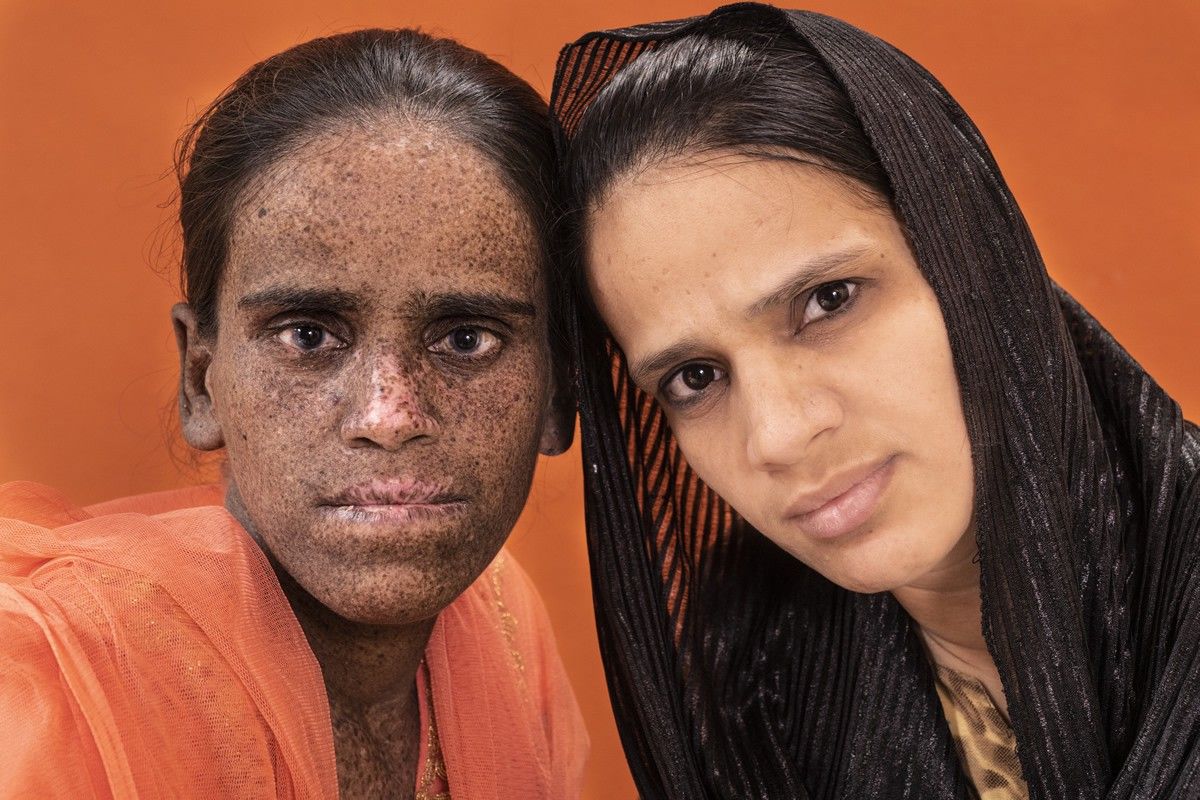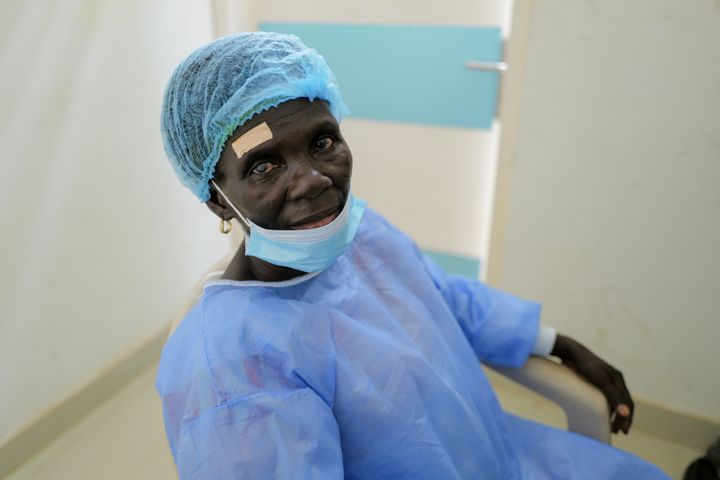Poverty blindness is a double disenfranchisement for women

Achieving gender equality in healthcare and education will help to prevent, alleviate and cure the poverty-driven blindness that disproportionately impacts women in poor communities.
According to the World Health Organisation of 39 million blind people in the world, 64% are girls and women. That is more than 25 million women in the world who are blind. 90 percent of them live in poor and developing countries where cultural, social, and economic factors act as a barrier for women to access information, medication, eye tests, and surgery – leaving women more exposed to blindness. The risk of going blind from trachoma in Africa is now up to four times greater for women than it is for men.
Blindness also disproportionately affects women because in poorer communities they are typically exposed to greater risk factors, such as proximity to children who carry the largest number of bacteria, as well as less access to medical care. Cataracts are the leading cause of blindness in developing countries, with symptoms that include a gradual blurring of vision which results in a total loss of sight if left untreated. Removing a cataract can cost as little as €32, but when even this is an inaccessible hurdle, women simply do not receive surgery at the same rate as men. Women account for nearly 75 percent of cataract blindness.
Women also account for 85 percent of the advanced and blinding cases of Trachoma, which is the second most prevalent cause of blindness in the developing world. Trachoma is a bacterial eye infection which left untreated causes immense pain as the eyelids turn inwards, making the eyelashes scratch the eyeball. A trachoma operation can restore eyesight for as little as €9, yet women remain disproportionately underserved when it comes to treatment, which exacerbates their higher propensity to contract the infection in the first place.

A cause and effect of poverty
Poverty predisposes women to blindness, and blindness exacerbates poverty by limiting employment opportunities and by incurring treatment costs that are far beyond their means. A study conducted in Pakistan found that the prevalence of total blindness was more than three times higher in poor clusters of the population than in affluent clusters.
Yet blindness does not just exacerbate existing poverty in poorer countries. It also causes people to become poor. A review on poverty and its consequences in developing nations found that although some individuals become disabled because of low income, 64% of those with disabilities were not in poverty prior to the onset of the disability. Households affected by a disability that was not initially impoverished had three times the probability of entering into poverty within one year compared with unaffected households.
Households affected by disability also have a lower probability of leaving poverty because of the increased costs and reduced earnings associated with disability. Prevalent blindness amongst women is thus not only a result of living in poverty, but also a cause of poverty.
A double disenfranchisement
There are currently 75 million children excluded from primary education in the developing world, and girls are significantly more likely to miss out than boys. In Sub-Saharan Africa alone, there are currently 18 million girls out of school primarily because families are more likely to take their daughters out of school than their sons to help with sick or frail relatives who may have become blind from diseases such as river blindness.
When families require girls to drop out of school to become caregivers and ‘substitute’ mothers for family members who have become blind, it impacts their education and has the trickle-down effect of limiting their human and social development and denying girls the opportunity to escape the poverty cycle. This creates a double disenfranchisement for women and girls: last in line to receive medical attention, and first to drop out of education.
Sightsavers cites the story of forty-year-old Lasoi from Kenya, who repeatedly suffered from trachoma until it led to total blindness. Lasoi was finding it a challenge to care for her seven children, so they had to drop out of school to help her. She was also struggling to do her beadwork, an essential income since her family had lost their cattle due to drought.
It wasn’t until Lasoi was screened by a Sightsavers team visiting her village that she learned her sight could be restored by a 20-minute operation, which changed her future and family. Lasoi’s story is, unfortunately, a sad reality for many families in the developing world who are forced to take children out of school to care for their blind relatives.

The impact of poverty blindness on families
The issue of access to medical care and education are thus inextricably linked and shape the destiny and prospects of women and girls in poor communities where poverty-driven blindness is prevalent and pervasive. Blindness and poor vision also have a tremendous impact on the quality of life for women with families who live in poor communities.
90 percent of blind individuals in poor communities cannot work. There are also often negative cultural stigmas associated with blindness that further alienate afflicted women from their local communities and disenfranchise them from their support structures: half of the blind people in impoverished countries report a loss of social standing and decision-making authority, and 80% of all women note a loss of authority within their families.
75 percent of visually impaired people in developing countries require assistance with everyday tasks and need to be led by either sighted children or by sighted adults. The physical and emotional toll of poverty-driven blindness thus impacts not just the individual and family but the social and economic fabric of communities. The sudden blindness of one individual in a family can become the tipping point for a family’s survival.
When a sighted woman becomes the caregiver, she often needs to stop working. Thus, there are long-term repercussions for family economics that extend beyond the blind individual. A study on poverty and cataract in Bangladesh, Kenya, and the Philippines found that cataract blindness resulted in restrictions of productivity of other household members in almost half of cases in Bangladesh and a quarter of cases in Kenya and the Philippines.

The impact of interventions
Organisations such as the Tej Kohli Foundation are committed to making interventions to prevent, alleviate and cure poverty-driven blindness and to establishing gender equality in access to treatment. Between 2016 and 2019 the Tej Kohli Cornea Institute in India made direct interventions that changed thousands of lives by taking existing treatments and cures directly into underserved communities whilst targeting and attaining gender equality.
Though blindness may lead women and girls to become trapped in poverty, health interventions have the potential to help women and their families to improve their socioeconomic status. An intervention study conducted in Kenya, the Philippines, and Bangladesh offered free or subsidised cataract surgery to those measured as living in poverty. Before the surgery, those with cataracts scored low in terms of per capita expenditure, assets, and wealth. However, just one year after the surgery, their per capita expenditure had increased significantly. The largest per capita expenditure increases were found among the cases that were poorest, to begin with before they received a free surgical intervention. Moreover, patients spent 1–2 hours more per day on productive activities compared to before surgery. Interventions that cure blindness do increase productivity and thus help to alleviate poverty.
Another study conducted at Aravind Eye Hospital in Madurai, India, similarly found that cataract surgery is an effective intervention that can break the cycle of poverty that many blind people are trapped in. The study found that 58% of the women who had lost their jobs as a result of blindness regained those jobs following cataract removal. In addition, some of those who did not return to work instead relieved other family members from household duties, enabling them, in turn, to return to work and improve family prospects.
The study also demonstrated that the average individual who regained vision because of a surgical intervention generated 1,500 percent of the cost of surgery in increased economic productivity during the first year following surgery. Thus, ophthalmologic interventions to treat blindness in disadvantaged communities help to end the destructive cycle of poverty.

A global solution to a global problem
Ending poverty blindness is an under-reported global challenge that humanity must rise to solve. Extrapolations of studies on a global level indicate that a successful universal eye care programme would prevent more than 100 million cases of blindness worldwide during the next twenty years, and consequently save at least $102 billion in lost productivity.
But the best — and most realistic — measures against poverty blindness are hygienic measures, education, and, most importantly, the realisation of gender equality. Ensuring that women receive equal access to medical treatment, particularly for treatable eye conditions such as cataracts and trachoma, can break once and for all the invisible chain that discriminates against women when it comes to medical treatment and education.

For more information on Tej Kohli as a philanthropist visit tejkohliruit.com and to read more of his views go to his Medium.
To read about Tej Kohli as an investor visit Kohli Ventures.
Find out more about Tej Kohli: Tej Kohli the technologist investing in human triumph, Tej Kohli the philanthropist trying to cure the developing world of cataracts and Tej Kohli the London tycoon with a generous streak.
| Follow: Twitter | Instagram | LinkedIn | Facebook | YouTube |




Comments ()